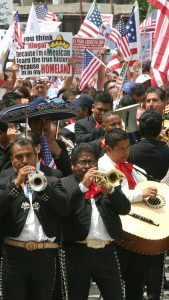In December of 2005 an immigration bill was passed that greatly increased the restrictions on immigration and undocumented immigrants. And although people from every country immigrate to the US, one community always seems to get singled out in the discussion: the Hispanic community. In response to the bill, protests occurred all across the country, with over a million people protesting in Los Angeles alone.
This picture, taken in Los Angeles during one of the protests, depicts a mariachi band leading the protest, framed by signs and waving american flags. To me, this image is a perfect representation of a cultural identity existing in America, being celebrated with music. The mariachi music is displaying feelings of pride in one’s culture and in one’s immigration status. The band, with their traditional clothing, displays a strong hispanic pride, while protesting in america shows a unity to the country and to their community. In fact, the sign behind the band reads, “If you think I’m ‘illegal’ because I’m a Mexican, learn the true history. Because I’m in my homeland,” most likely referring to the Pobladores, a group of Mexican families who lived in (and named!) Los Angeles before the USA existed.
I think that by performing and leading this protest, the mariachi band is completing the highest form of protest: celebration. By celebrating hispanic heritage and culture with mariachi music– something that’s usually joyful and special– their placing the joy of their culture and their community within the view of people outside of their community (ie. white people). Their adding to the significant history of protest music in the US, a genre that captures the emotions and qualms of politic unrest in the US.
The music at the protest also somehow makes the atmosphere more lighthearted, which is sometimes needed at a protest, to remind people that their is hope and a future worth protesting for.
Interestingly, many of the areas in which mariachi is suspected to have originated are the same areas from which mexican immigrants are from. Zacatecas, Guanajuato, and Sinoloa are all areas with heavy emigration and areas in which there is a strong mariachi presence.
Below is an example of mariachi music being played at a protest– this time against Donald Trump, who is famously anti-hispanic immigration.
http://https://www.youtube.com/watch?v=FLkG7l-cy5E
bibiolography:
“Mariachi Band Leads Protesters.” The American Mosaic: The Latino American Experience, ABC-CLIO, 2021, latinoamerican2.abc-clio.com/Search/Display/1602762. Accessed 27 Sept. 2021.
Hameed, Fatimah. Millions in the U.S. Protest Immigration Policy, 2006, https://nvdatabase.swarthmore.edu/content/millions-us-protest-immigration-policy-2006. Accessed 26 Sept. 2021.
“LA History.” COUNTY OF LOS ANGELES, 15 Nov. 2017, https://lacounty.gov/government/about-la-county/history/.

